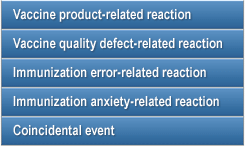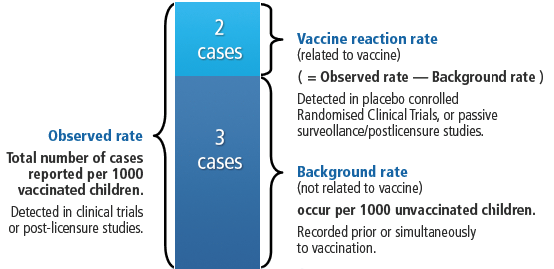Adverse events: Frequency and severity
Under recommended conditions, vaccines should cause no adverse events and completely prevent the infection that they target. Unfortunately, current technology does not allow for such perfection. The key therefore is to minimize as much as possible adverse events and ensure a safe use of vaccines.

Adverse events following immunization (AEFIs) are classified by the cause of the event. As you have learned previously, when an AEFI is caused by the properties of the vaccine, it is classified as a vaccine (product or quality related) reaction. Other categories include immunization error-related, and immunization anxiety-related reactions and coincidental events.
Key point
Vaccine adverse events are expected to occur with a certain frequency.
AEFI surveillance![]() AEFI surveillance (also known as vaccine safety surveillance)A surveillance system designed to collect adverse events temporally associated with receipt of vaccines. This type of surveillance typically relies on health professionals associating an adverse event in an individual as a possible consequence of vaccination and reporting it to the NRA or appropriate authority. monitors adverse events and follows up severe events that may have been due to the vaccine.
AEFI surveillance (also known as vaccine safety surveillance)A surveillance system designed to collect adverse events temporally associated with receipt of vaccines. This type of surveillance typically relies on health professionals associating an adverse event in an individual as a possible consequence of vaccination and reporting it to the NRA or appropriate authority. monitors adverse events and follows up severe events that may have been due to the vaccine.
Frequency and severity of adverse vaccine reactions
| Frequency | Occurrence among persons vaccinated in percent | Severity of reactions |
|---|---|---|
| Very common | ≥ 10% | Common and usually minor reactions:
|
| Common (frequent) | ≥ 1% and < 10% | |
| Uncommon (infrequent) | ≥ 0.1% and < 1% | Rare, usually more severe reactions:
|
| Rare | ≥ 0.01% and < 0.1% | |
| Very rare | < 0.01% |
Question
Which of the following statements is wrong:
| A. An event that occurs in 12 out of a hundred persons is regarded as very common. | |
| B. An event that occurs in 2 out of a hundred persons is regarded as common. | |
| C. An event that occurs in 1 out of 20,000 is regarded as very rare. | |
| D. An event that occurs in 2 out of a thousand persons is regarded as common. | |
| E. An event that occurs in 1 out of 9,000 is regarded as rare. |
Answer D is wrong.
An event that occurs in 2 out of a thousand persons is regarded as uncommon (infrequent).
Please compare the frequency and the Percentage of persons vaccinated in the table above.
Background rates
Background rates of vaccine adverse reactions worldwide are published by WHO. Background rates differ from country to country because of differences in national surveillance systems. Understanding the background rates in a specific population is useful for monitoring the sensitivity of the AEFI surveillance system in detecting changes in the frequency of vaccine reactions.
For example, using the background rate in comparison to the observed rate can be helpful to determine the reaction rate of a vaccine (see graphic).

Any increase in the frequency of AEFIs should alert you to consider the quality of the vaccine and whether there are special risks in local populations. In addition, knowing when vaccine reactions may appear (time to onset![]() Time to onsetThe period of time between an intervention (in this case, a vaccination) and the onset of an adverse reaction to the vaccine.) is useful for investigating and verifying cases, as Module 4 will describe.
Time to onsetThe period of time between an intervention (in this case, a vaccination) and the onset of an adverse reaction to the vaccine.) is useful for investigating and verifying cases, as Module 4 will describe.
Key point
Knowing the background rates in your population is essential in detecting changes in the frequency of vaccine reactions and identifying trends of concern, such as rates reported by AEFI surveillance that are higher than expected.

